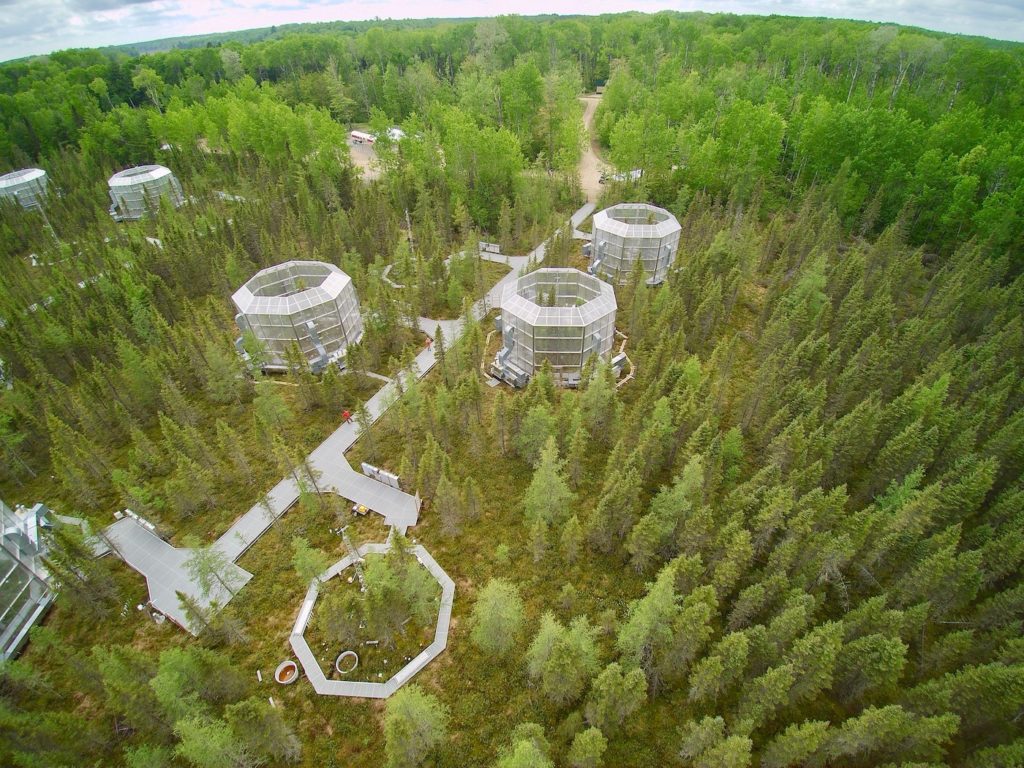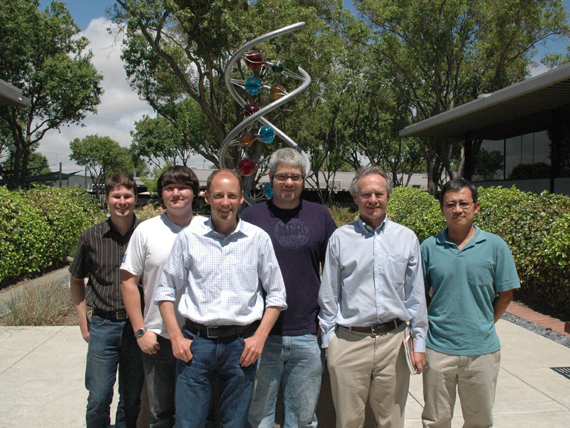A former JGI intern is now applying his internship lessons on presentations to peatlands

Scientists use the Spruce and Peatland Responses Under Changing Environments experiment in Minnesota to assess the response of northern peatlands to increases in temperature and atmospheric carbon dioxide. (ORNL, U.S. Dept. of Energy, CC BY 2.0)
Travis Lawrence sits in his backyard in Tennessee — the birds are chirping and a soft breeze ripples through the trees in his backyard. Originally from northern California and one of the first students to participate in the DOE Joint Genome Institute (JGI)-UC Merced internship program, Lawrence is now a postdoctoral researcher at the Oak Ridge National Laboratory (ORNL), based in Oak Ridge, Tennessee.
Recently, Lawrence, in collaboration with researchers from ORNL, Lawrence Berkeley National Laboratory, the HudsonAlpha Institute for Biotechnology, and Duke University, published their research related to how bacteria that colonize the roots of sphagnum work to transfer their thermotolerance abilities. This capacity to survive elevated temperatures that normally would kill the moss may hold clues to how these carbon sink environments can continue to hold onto their carbon despite global warming.
At ORNL, Lawrence brings a bioinformatics expertise, a combination of biology and computer science, to reveal clues about how microbial and bacteria communities influence the carbon-sequestering abilities of peat moss. Peat is found in the temperate north, in U.S.-based places like Minnesota for example, despite taking up only about 3% of the planet’s landmass, peat moss and their subsurface bogs hold over 30% of the world’s carbon. “This makes it one of the most efficient carbon-sucking ecosystems on the planet,” Lawrence said.
For Lawrence, this work is fundamentally meaningful given its relevance to the global climate change crisis. And, it’s an opportunity to contribute to the rapidly expanding field of bioinformatics. When Lawrence embarked on his PhD program at UC Merced in 2013, this field was just beginning to develop and expand into the world of evolutionary biology.
And around that time, a collaborative internship program between the JGI and UC Merced faculty focused on bioinformatics was coalescing. Lawrence applied for and was accepted as one of the first interns in the program. “There was a lot of freedom to explore,” he recalled. His project involved developing an algorithm and although the scope of work was established before he began, Lawrence remembers lots of flexibility as his internship and investigations began.

Travis Lawrence (third from right) at the end of his 2014 internship with JGI mentors. From left to right: Ben Cole, Keedrian Olmstead, Axel Visel, Lawrence, then JGI Director Eddy Rubin, and Lawrence’s mentor, Zhong Wang.
Lawrence was paired with program co-founder and JGI mentor, Zhong Wang. Together, they worked to develop a tool that leveraged machine learning to help users determine which computer program would best serve their quests related to processing RNA-sequencing information.
According to Lawrence, this summer project aligned with his computational background and interests nicely. And although his work on this project was only the beginning of this much longer-term body of work, the experience helped to solidify Lawrence’s interest in pursuing bioinformatics and machine learning. He also learned what it was like working at a national lab and DOE campus.
“Between the level of knowledge and experience sitting on the [Walnut Creek] campus … It was a resource-rich environment,” Lawrence said. While interning, he recalls interacting with renowned scientists who were involved in the Human Genome Project, or computational biologists who were contributing to cutting edge developments in machine learning.
Despite working alongside his scientific idols, Lawrence recalls feeling very comfortable. As a part of his internship, he was regularly tasked by his mentor to present his project work and navigate a follow up question and answer session. “A great presentation not only helps students effectively communicate their research and receive input during the internship, but it also helps to spread the science stories of JGI to a broader audience after the students return to their academic communities,” Wang said.
Wang, a vocal advocate on the importance of giving scientific presentations, maintains this expectation of his UC Merced interns today. Additionally, the entire cohort is required to participate in both a midterm and a final round of presentations.
“That really helped build my communication skills. Their questions were often really focused and it informed me of what people were looking for and what I was probably missing,” Lawrence said. He also learned how to build graphics that accompany and help to explain the results. Based on the type of questions and feedback from his JGI audiences, he began to understand what worked well to explain something at a glance and, in some cases, what didn’t.
After wrapping up his summer internship, Lawrence continued to build on these presentation skills and noted their benefits during his PhD dissertation defense presentations and beyond. In 2018, a friend of his wife’s passed along an open postdoc position at ORNL. Given his previous exposure to the national lab system and positive experience, he decided to apply. After a few rounds of virtual interviews, Lawrence joined the SPRUCE team, which aims to predict what might happen to the carbon trapped in the peatlands as the world warms.
Lawrence and his colleagues will likely hit the road and begin attending scientific conferences soon, and he’s looking forward to presenting on these findings and the larger implications of the work. In addition to preparing slides and anticipating the inevitable questions about the study’s methods and analysis, Lawrence is spending time on the graphics that will help to represent their findings.
“The graphics, they’re essentially distilling complex things … they really just help get your point across as quickly as possible,” he said. After years of practice presenting his science and learning what type of content and graphics land well with those in the audience, he’s always working to fine tune his approach. “I got a lot of that from Zhong.”
Publication: Carrell AA et al. Habitat-adapted microbial communities mediate Sphagnum peatmoss resilience to warming. New Phytol. 2022 Jun;234(6):2111-2125. doi: 10.1111/nph.18072.
Byline: Ashleigh Papp